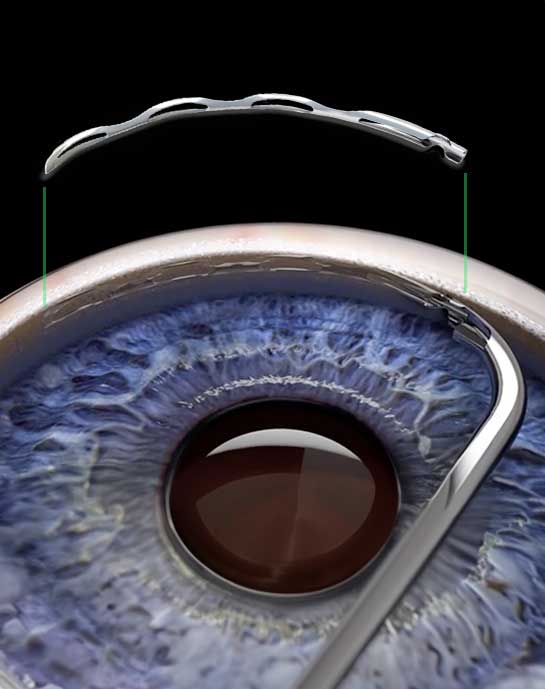Hydrus Microstent


Alcon Hydrus Microstent for Glaucoma
Advanced MIGS for Long-Term Eye Pressure Relief in Austin, Kyle, Killeen & New Braunfels
For patients seeking a longer-term solution to manage mild to moderate open-angle glaucoma, the Alcon Hydrus® Microstent offers an innovative option. Often referred to as the “intracanalicular scaffold,” the Hydrus works by enhancing and expanding Schlemm’s canal, the eye’s natural drainage system.
At Westlake Eye Specialists, we are proud to offer the Hydrus Microstent as part of our advanced MIGS (Minimally Invasive Glaucoma Surgery) program. Under the care of Harvard-trained glaucoma specialist Dr. Zarmeena Vendal, MD, patients across Austin, Kyle, Killeen, and New Braunfels receive the most effective and personalized glaucoma treatments available.
What Is the Hydrus Microstent?
The Alcon Hydrus Microstent is a tiny, flexible device made of a biocompatible metal alloy called nitinol. It’s inserted into Schlemm’s canal during cataract surgery or as a stand-alone procedure. Unlike other MIGS implants, Hydrus spans about 90 degrees of the canal, acting as a scaffold to widen the channel and promote more consistent fluid drainage.
The result is a significant reduction in intraocular pressure (IOP)—often enough to reduce or eliminate the need for daily glaucoma medications.

Benefits of the Hydrus Microstent
- Widest canal coverage of any MIGS device (90°)
- Promotes long-term outflow through natural drainage
- Can be performed during cataract surgery or as a separate procedure
- Reduces reliance on glaucoma medications
- FDA-approved and clinically proven in long-term studies
- Covered by Medicare and most insurance providers when medically indicated

Ideal Candidates for Hydrus
The Hydrus Microstent may be a good fit if you:
- Have mild to moderate primary open-angle glaucoma
- Are undergoing cataract surgery, or want a standalone MIGS option
- Require long-term pressure control
- Have not had success with eye drops or laser treatments
- Want to avoid more invasive procedures like trabeculectomy
Dr. Zarmeena Vendal carefully assesses your glaucoma severity, eye anatomy, and previous treatment history to determine if Hydrus is right for you.
What Happens During the Procedure?
The Hydrus Microstent is typically placed during cataract surgery, but it can also be done independently for patients without cataracts.
- Topical anesthesia is used to numb the eye
- A tiny self-sealing incision is made
- The Hydrus Microstent is carefully inserted into Schlemm’s canal using a microscopic delivery system
- No stitches are required, and the procedure takes just minutes
Recovery and Long-Term Results
- Recovery is generally fast and similar to standard cataract surgery
- Vision typically improves as the eye heals
- Most patients experience a noticeable drop in IOP within days
- The Hydrus remains in place permanently and requires no maintenance
- Many patients are able to reduce or eliminate daily eye drops
In long-term studies, patients with Hydrus experienced significantly better IOP control over five years compared to those with cataract surgery alone.
Why Choose Westlake Eye Specialists?
At Westlake Eye Specialists, we’re committed to offering the full spectrum of MIGS technologies—not just one option. With Dr. Zarmeena Vendal’s Harvard-level training in glaucoma surgery, we’re able to tailor each treatment plan to your unique needs.
We are proud to serve patients in:
- Austin
- Kyle
- Killeen
- New Braunfels
From the moment you walk in, you’ll experience compassionate care, advanced technology, and a team dedicated to preserving your sight.
Schedule a Glaucoma Consultation Today
If you’ve been struggling with elevated eye pressure or are preparing for cataract surgery, ask us if the Hydrus Microstent could be the right solution for your glaucoma.
Call today or book your consultation online with Dr. Zarmeena Vendal, MD, and discover a more sustainable approach to glaucoma care.

